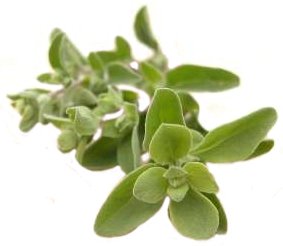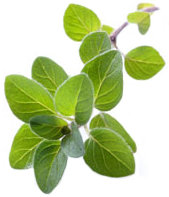

Marjoram and Oregano

Since marjoram and oregano are from the same genus they will both be featured in this section. Origanum. (From Greek oros, mountain, and ganos joy.) MARJORAM; OREGANO. Labiatae. Some 20 species of subshrubs or perennial herbs to 1m. Stems quadrangular in section, often pubescent, generally rhizomatous. Leaves usually simple, opposite, aromatic, petiolate, over 1cm wide. Inflorescence a spike-like arrangement of whorled flowers appearing paniculate or corymbose; bracts conspicuous, imbricate, usually coloured; calyx campanulate or funnel-shaped, pubescent, generally actinomorphic and 5-toothed or 1-2-lipped; corolla 2-lipped, upper lip entire, lower lip 3-lobed; stamens 4, 2 long and projecting; style single, arising from a depression in the middle of a 4-lobed ovary. Fruit a single-seeded nutlet. Mediterranean to E Asia. CultivationNative to the mountains of the Mediteranean, Origanum was cultivated as a culinary and medicial herb in Ancient Egypt. In the garden. it is also used as low ground cover in borders or scree beds. Choicer alpine species like Origanum amanum and Origanum rotundifolium are grown on sunny screes or in the alpine house in pans of equal parts loam, leafmould and sharp sand. Plant 30cm apart in spring in any well-drained soil, in an open sunny site. Origanum rotundifolia must have lime-free soil; other species prefer slightly alkaline conditions. Trim back after flowering. Mulch Origanum majorana in cold winter areas. Harvest for freezing or drying just before the flower buds open. Propagate from seed in early spring, sown at 10-13ºC, or later in drills in open ground, thinning to 30cm. Alternatively, take 5-8cm softwood cuttings in early summer, pot on individually, overwinter in frostfree conditions and plant out the following spring. Winter supplies for the kitchen may be taken as cuttings in summer and overwintered at a minimum of 10ºC. Origanum majoranaSWEET MARJORAM; KNOTTED MARJORAM. Annual, biennial or perennial herb to 60cm. Stems glabrous or tomentose, red. Leaves to 2cm, opposite, ovate, grey, pubescent. Inflorescence a dense terminal panicle; bracts grey-green, to 4 x 3mm, elliptic, obtuse; flowers tubular, white, mauve or pink, to 8mm; calyx untoothed, 2-lobed. Late summer-autumn. Originally Mediterranean and Turkey, now widespread in Europe as an escapee. Z7. Origanum vulgareWILD MARJORAM; OREGANO; POT MARJORAM. Rhizomatous, woody, branched perennial herb to 90cm, strongly aromatic. Leaves to 4cm, short-petiolate, round to ovate, entire or slightly toothed, spotted-glandular beneath. Inflorescence a loose panicle or corymb; bracts to 10mm, twice length of calyx, violet-purple or green, ovate-elliptic; petals purple, to 4mm. Late summer and autumn. Almost all Europe in open woodland, generally on lime-rich soils. ‘Album’: to 25cm, bushy; leaves light green; flowers white. ‘Aureum’: to 30cm, spreading; leaves small, gold in summer, burn in sun; flowers lavender. ‘Aureum Crispum’: leaves golden, curly. ‘Compactum’: to 15cm, compact and cushion-forming; leaves small, round, dark green; flowers pink tinted violet, profuse. ‘Compactum Nanum’: to 10cm, compact; leaves dark green, purple in winter; flowers lilac. ‘Gold Tip’: leaves tipped in yellow. ‘Heiderose’: to 40cm, bushy, upright; flowers pink. ‘Heideturum’: to 50cm; flowers light pink. ‘Nanum’: dwarf, to 20cm; flowers purple. ‘Roseum’: flowers pink. ‘Thumble’s Variety’: to 35cm; leaves large, pale yellow later yellow-green, non-burning; flowers soft white, inconspicuous. ‘Tracy’s Yellow’: vigorous; leaves gold. subspecies vulgare. Leaves and calyx usually not glandular-punctate, stems and leaves pilose, bracts partly purple often glabrescent; corolla pink. Mediterranean, E to S China. subspecies hirtum. Leaves and calyx usually glandular-punctate, stems leaves and calyx densely hirsute, bracts green-hirsute, corolla white. Inflorescence usually compact, branches and spikes short. Greece, Turkey, Aegean Islands. subspecies gracile. Leaves and calyx usualy glandular-punctate, stems leaves and calyx glabrescent to puberulent, leaves more or less glaucous, bracts green, glabrescent. Inflorescence usually lax, branches and spikes slender. E Anatolia. subspecies viride. Leaves and calyx not usually glandular-punctate, stems and leaves pilose, bracts green, rarely purple-tinged, often puberulent; corolla white or rarely pale pink. N and C Turkey. Z5.
|
Home
Grow Nuts
Grow Fruit
Grow Vegetables
Cyberian Index
If you like this website and want one of your own contact
Cyberian All information correct at
time of publication and open to updates as necessary. No part of this website,
or its vectors, may be produced in any shape or form, using any type or design
of medium, system, equipment or otherwise without the prior written consensual
notice of the Cyberian. Any breach of these requirements will result in the
appropriate action. If in doubt, e-mail contact is recommended.
Some components of this website were obtained as open-source software and are
used in the same non-profit manner on this website.